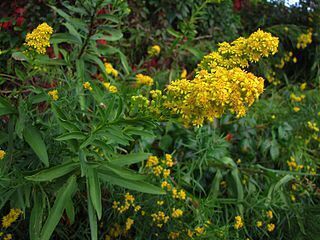Seaside Goldenrod
Solidago sempervirens
Family: Asteraceae (Aster Family)
Seaside Goldenrod (Solidago sempervirens) is a hardy, salt-tolerant perennial native to coastal regions of Texas, including Southeast Texas. With its bright yellow flower clusters and upright growth habit, it is an important late-season nectar source for pollinators. This resilient wildflower thrives in sandy soils and is a valuable addition to coastal prairie restorations and pollinator gardens.
- Scientific Name: Solidago sempervirens
- Common Names: Seaside Goldenrod
- Family: Asteraceae (Aster Family)
- Growth Habit: Upright perennial
- Height: 2-6 feet
- Leaves: Thick, fleshy, lance-shaped, glossy green
- Flowers: Dense, bright yellow flower clusters on tall stems
- Bloom Time: August – November in Southeast Texas
- Wildlife Benefits: Attracts butterflies, bees, and migrating monarchs
Habitat & Range in Southeast Texas
Seaside Goldenrod is well adapted to coastal environments and thrives in:
- Coastal Prairies & Dunes: Flourishes in sandy, well-drained soils
- Salt Marsh Edges: Tolerant of saline conditions
- Disturbed Areas: Common along roadsides and open fields
Its adaptability makes it an excellent plant for erosion control and habitat restoration in coastal regions.
Ecological Importance
- Pollinator Support: Provides nectar for bees, butterflies, and migrating monarchs in the fall.
- Erosion Control: Deep roots help stabilize sandy soils and prevent erosion.
- Resilient Species: Tolerates drought, salt spray, and poor soils, making it ideal for coastal plantings.
Landscaping & Gardening Uses
Seaside Goldenrod is a striking addition to native plant gardens and coastal landscapes.
Planting & Care
- Sunlight: Full sun
- Soil: Prefers sandy, well-drained soils but adapts to clay and loam
- Water Needs: Low; drought- and salt-tolerant once established
- Maintenance: Minimal; cut back in late winter to encourage new growth
- Companion Plants: Grows well alongside Gulf Muhly (Muhlenbergia capillaris), Marsh Elder (Iva frutescens), and Dune Sunflower (Helianthus debilis)
Fun Facts
- Unlike other goldenrod species, Solidago sempervirens is highly salt-tolerant and thrives in coastal habitats.
- It plays a crucial role in supporting late-season pollinators, including migrating monarch butterflies.
- Seaside Goldenrod does not cause hay fever; its pollen is too heavy to become airborne.
Conservation & Native Plant Advocacy
As coastal ecosystems face increased threats from development and climate change, planting native species like Seaside Goldenrod supports local biodiversity and helps maintain resilient landscapes.
Where to Find It
-
Interested in adding Seaside Goldenrod to your garden? Check if this is in stock or add to cart to purchase directly from our Natives Nursery.



